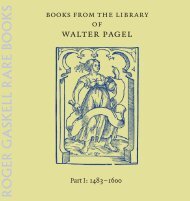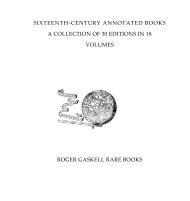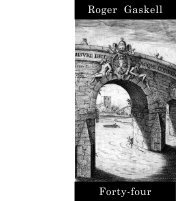pdf - Roger Gaskell Rare Books
pdf - Roger Gaskell Rare Books
pdf - Roger Gaskell Rare Books
You also want an ePaper? Increase the reach of your titles
YUMPU automatically turns print PDFs into web optimized ePapers that Google loves.
nearest way to physick and chyrurgery... being an anatomical description<br />
of the whole body of man (1657) translated from the present edition<br />
but with the plates used by Culpeper in his translation of Vesling<br />
published in 1653 (Russell, British Anatomy, 2nd edition, 1987, p.<br />
168.) Krivatsy 9667; Waller 7997; Wellcome IV, p. 530.<br />
This is the Wrst illustrated edition of Riolan’s compendium of anatomy, in<br />
which he expressed his opposition to Harvey’s view of the circulation of the<br />
blood. Riolan only believed in a partial circulation, through the lungs and<br />
through the supposed septum of the heart. Despite many critics Harvey had<br />
remained silent for 21 years since the publication of De motu cordis in 1628,<br />
but it was the Wrst edition of this work (1648) of Riolan’s that Wnally provoked<br />
him to reply to his critics, in Exercitatio anatomica de circulatione sanguinis<br />
(Cambridge, 1649). ‘Riolan was one of the most famous anatomists of his<br />
time, and so was perhaps regarded by Harvey as specially worthy of an answer,<br />
although by no means all his earlier opponents had been lesser lights’ (Keynes,<br />
Bibliography of the writings of Dr William Harvey, 3rd ed. 1898, p. 72).<br />
The Wne engraved titlepage by Reinier van Persijn (c. 1614–1668) incorporates<br />
a dissection scene with portraits of Vesling, Riolan, A. Valcob, Guy<br />
Patin and Albert Kijper. Behind them stand the Wgures of Medicina and<br />
Asklepios, on either side of a cupboard containing surgical instruments.<br />
Plates III and XXIV are signed by Persijn, and the rest are clearly by the<br />
same hand.<br />
An interesting insight into the expected distribution of this book, and<br />
the international nature of Dutch publishing at this period, is revealed by<br />
the directions to the binder which are given in Latin, French, German and<br />
Dutch.<br />
The plates are constructed in an unusual way, each having a conjugate leaf<br />
of letterpress captions (thus there are 24 letterpress leaves, printed on versos<br />
only). They were apparently printed on larger sheets, but as the instruction<br />
to the binder indicates, these were cut up (using a template supplied by<br />
the publisher) and stitched as 2 leaf sections, with the plate larger than its<br />
accompanying text and folded in. The binder was instructed to make the<br />
folds so that they were not in exactly the same place on adjacent plates and<br />
then to trim the book as little as possible.<br />
Wellcome and STCN describe a blank leaf 2C6, but in this copy the sewing<br />
is between 2C2 and 3, so 2C seems to be a 4 leaf section plus a biofolium,<br />
the second leaf of which is blank (and in this copy folded back so that the<br />
stub is between sigs 2B and 2C).<br />
163<br />
RuDBECK, Olof (1630–1702)<br />
Insidiae structae Olai Rudbeckii Sveci ductibus hepaticis<br />
aquosis & vasis glandularum serosis, Arosiae editis, a Thoma<br />
Bartholino.<br />
Leiden: Ex oYcina Adriani Wingaerden, 1654.<br />
8vo: p 2 A–I 8 K 6 L 4 (blank p2), 84 leaves, pp. [4] 164 (second leaf<br />
blank), printer’s device on title, woodcut diagram on H8v.







